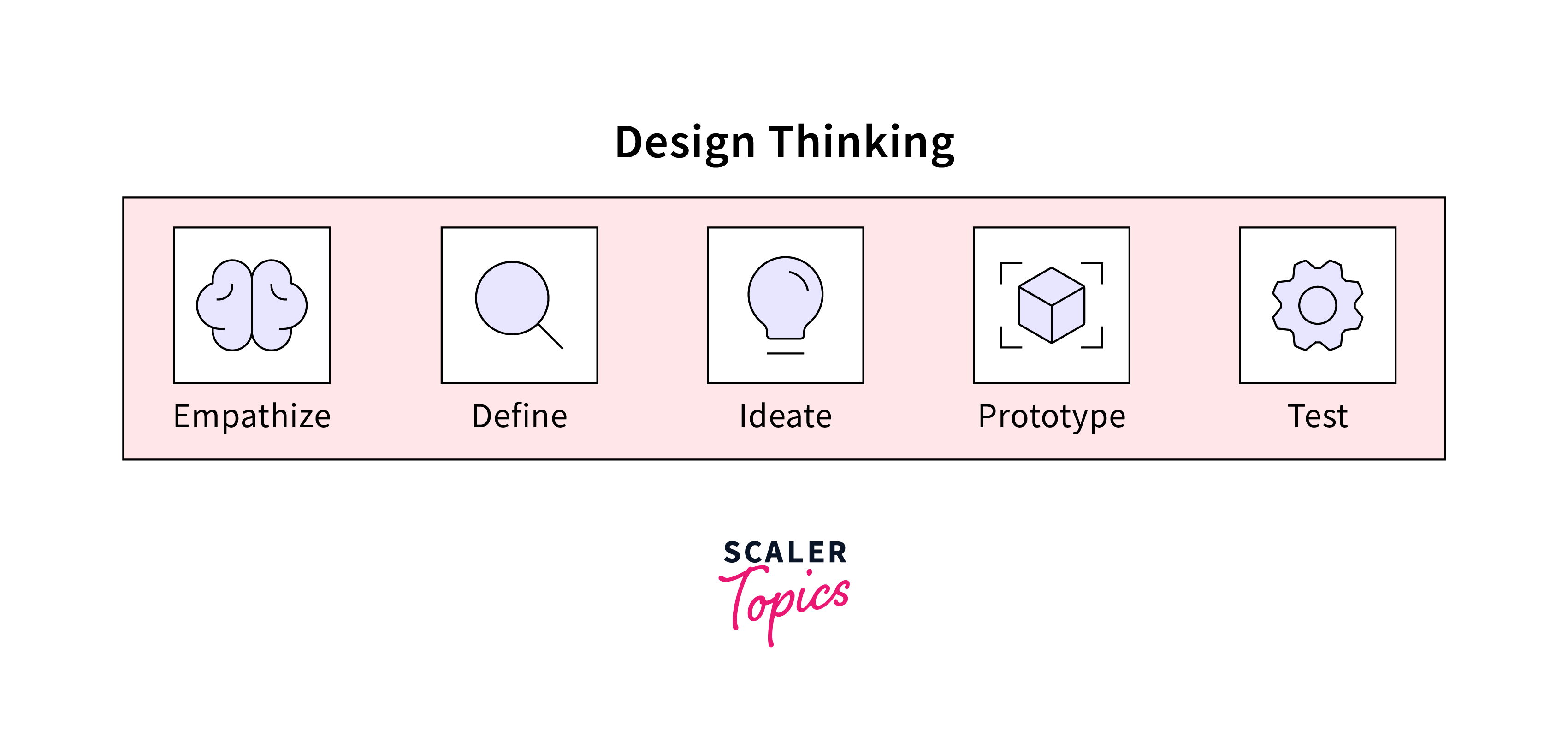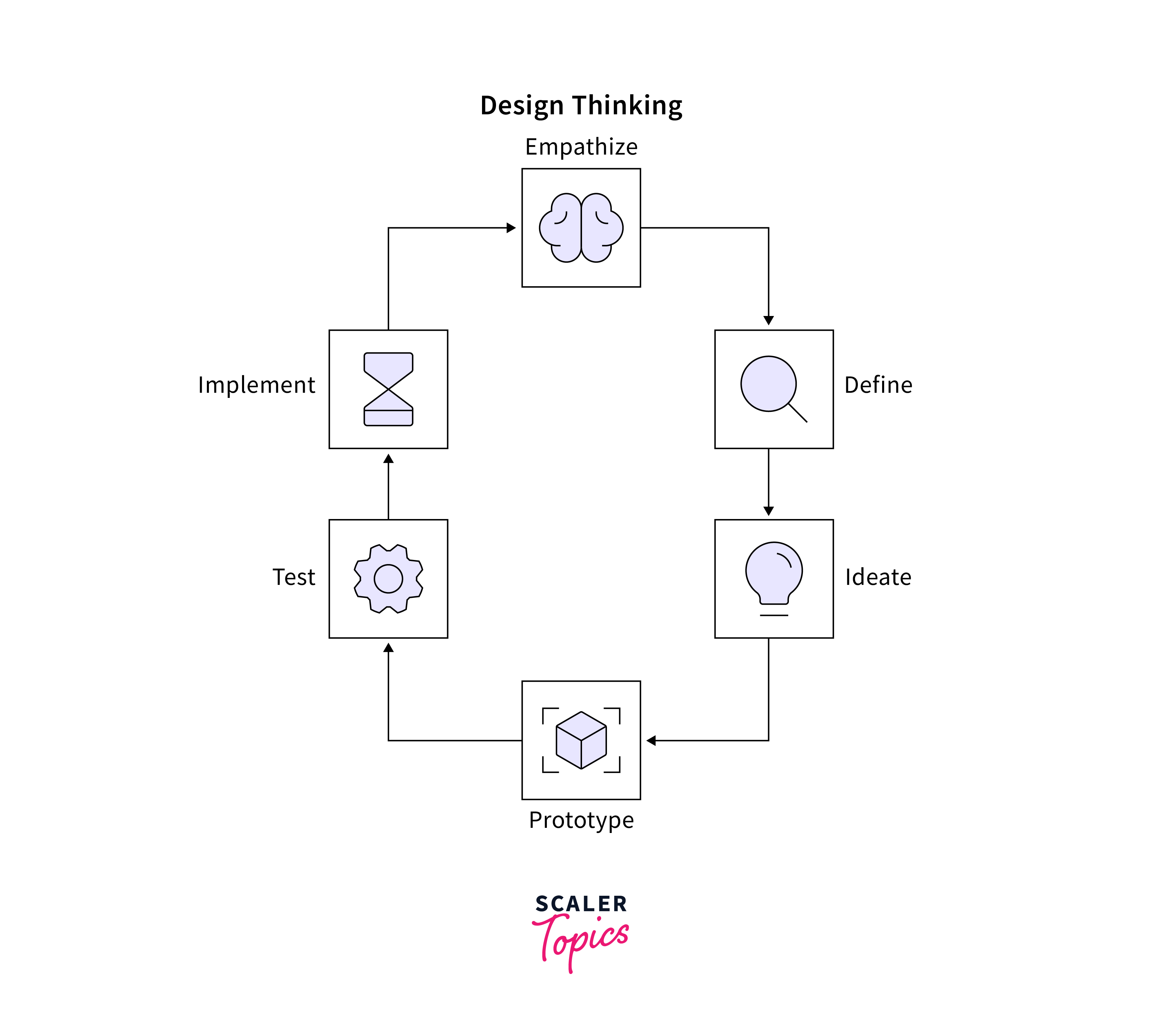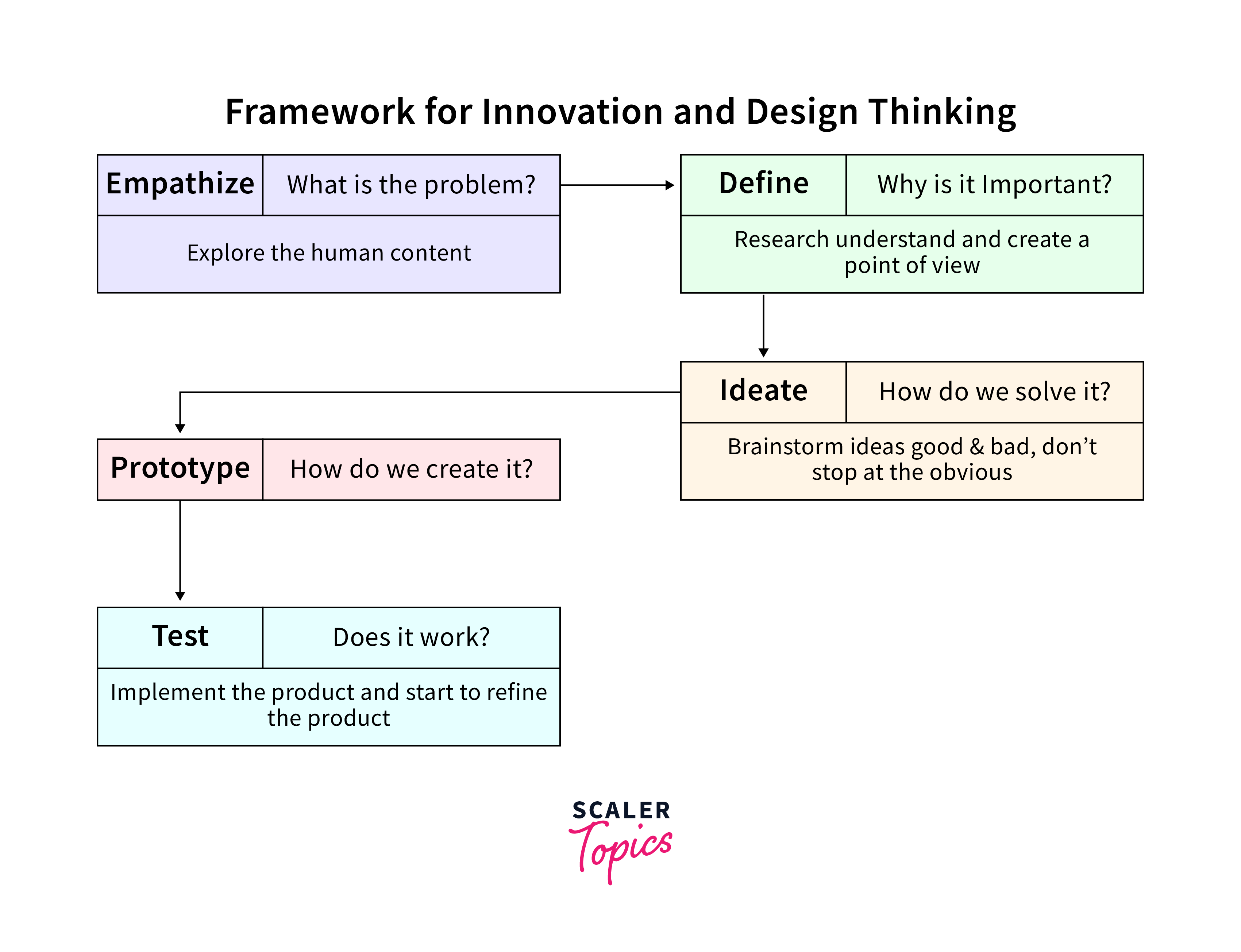Design Thinking and Innovation
Design Thinking in software development is an iterative and human-centric approach to problem-solving, emphasizing empathy, ideation, and prototyping. It begins with understanding user needs, involves collaborative brainstorming, and employs rapid iterations for testing and refining solutions. This user-focused methodology fosters innovation by encouraging creativity, user feedback, and adaptability. In software development, Design Thinking ensures the delivery of user-centric, intuitive, and effective solutions. It promotes a culture of continuous improvement, where developers empathize with end-users, ideate diverse solutions, and iteratively refine software interfaces and functionalities. Ultimately, this process enhances the overall user experience and drives innovation in the ever-evolving landscape of software development.
What is Design Thinking?

Design Thinking is a human-centered, iterative approach to problem-solving that prioritizes understanding users and their needs. This innovative methodology follows a structured process:
- Empathy:
Begin by empathizing with users to gain insights into their experiences and challenges. - Define:
Clearly articulate the problem based on user needs, ensuring a focused and meaningful scope. - Ideate:
Encourage diverse brainstorming to generate a wide array of creative solutions. - Prototype:
Develop tangible representations of ideas for quick testing and feedback. - Test:
Iteratively test prototypes with users to refine and improve solutions.
Design Thinking emphasizes collaboration, iteration, and a willingness to challenge assumptions, fostering a culture of continuous improvement. It transcends traditional problem-solving by prioritizing user perspectives, promoting creativity, and adapting to evolving needs. Applied across various domains, from product design to software development, Design Thinking empowers teams to deliver solutions that truly resonate with and address the needs of end-users.
Why is Design Thinking So Important?
Design Thinking holds immense significance in various fields due to its profound impact on problem-solving and innovation. Here's why it stands out:
- User-Centric Focus:
Prioritizing the user perspective ensures solutions directly address their needs and challenges. - Innovation Catalyst:
By fostering a culture of creativity and open-mindedness, Design Thinking becomes a catalyst for continuous innovation. - Adaptability:
The iterative nature of Design Thinking allows for quick adjustments based on real-world feedback, promoting adaptability. - Collaborative Approach:
Encouraging diverse teams to work together enhances collaboration, resulting in more holistic and effective solutions. - Problem Reframing:
It encourages teams to challenge assumptions and reframe problems, leading to more insightful and effective problem-solving.
In essence, Design Thinking is crucial for its ability to drive innovation, improve user satisfaction, and tackle complex challenges in a dynamic and evolving landscape.
The 5 Phases of Design Thinking
Design Thinking is a structured approach that consists of five distinct phases, each crucial for fostering innovation and solving complex problems.
- Empathize:
- User Understanding:
The first phase involves immersing oneself in the user's world to gain a deep understanding of their needs, emotions, and experiences. - Observation and Engagement:
Empathy is built through observations, interviews, and direct engagement with users to uncover insights.
- User Understanding:
- Define:
- Problem Articulation:
In this phase, the identified insights are synthesized to clearly define the core problem or challenge that needs to be addressed. - User-Centric Definition:
The problem is framed in a user-centric manner, ensuring a focused and meaningful scope for subsequent stages.
- Problem Articulation:
- Ideate:
- Divergent Thinking:
Ideation encourages expansive and creative brainstorming to generate a wide range of potential solutions. - Encouraging Creativity:
Teams explore unconventional ideas, pushing beyond the obvious, and fostering an environment that values creativity.
- Divergent Thinking:
- Prototype:
- Tangible Solutions:
Prototyping involves transforming selected ideas into tangible representations, allowing for a more concrete understanding and testing of concepts. - Quick Iterations:
The focus is on rapid iterations and refinement, enabling teams to learn and adapt based on the feedback generated through prototyping.
- Tangible Solutions:
- Test:
- User Feedback:
The final phase involves testing prototypes with users to gather feedback and insights. - Iterative Refinement:
Based on user responses, teams iteratively refine their solutions, ensuring that the final product meets user needs effectively.
- User Feedback:
Design Thinking promotes a non-linear, iterative process where these phases may overlap or be revisited as necessary. This holistic approach ensures a comprehensive understanding of the problem, encourages creative problem-solving, and results in innovative solutions that genuinely address user needs.
Distinctions Between Design and Design Thinking
| Aspect | Design | Design Thinking |
|---|---|---|
| Focus | Primarily product-focused. | Broad, focusing on problem-solving and innovation. |
| Process | Linear process, often starting with a brief. | Iterative process, adaptable and user-centric. |
| User Involvement | Users consulted, but not always central. | Emphasizes deep user engagement throughout. |
| Problem Framing | Problem framed within a given context. | Actively reframes problems from a user perspective. |
| Mindset | Often specialized, expertise-driven. | Inclusive, collaborative, and open-minded mindset. |
| Iteration | Limited iterations during development. | Encourages rapid and continuous iterations. |
| Outcome | Focuses on the final product or solution. | Prioritizes innovative solutions and user experiences. |
| Creativity | Creativity important but may follow rules. | Values divergent thinking and explores unconventional ideas. |
| Problem-Solving | Problem-solving within defined constraints. | Aims at reframing problems and finding holistic solutions. |
| Feedback | Feedback obtained at specific stages. | Constant feedback loop, especially during prototyping. |
| Adaptability | Limited adaptability once underway. | Embraces adaptability and responds to evolving needs. |
Driving Force Behind Design Thinking

Design Thinking thrives on user-centric solutions and innovation, guided by key principles:
- Empathy:
Understanding user perspectives ensures solutions resonate with end-users. - Creativity:
Emphasizing unconventional ideas and challenging assumptions breaks away from conventional thinking. - Iterative Problem-Solving:
Constant refinement, guided by user feedback, leads to effective outcomes. - Collaboration:
Diverse expertise in a collaborative environment generates comprehensive and innovative solutions. - Human-Centered Design:
Placing users at the core ensures impactful products or experiences. - Problem Reframing:
Challenge traditional problem framing to find insightful definitions and effective solutions.
Problems Addressed by Design Thinking and Innovation
- Complex Issues:
Tackling problems without straightforward solutions, requiring deep understanding of user needs. - User Experience Enhancement:
Optimizing the user experience of products, services, or processes. - Market Disruption:
Creating groundbreaking solutions challenging existing norms, contributing to market disruption. - Product Development:
Guiding development to ensure solutions align with user preferences and needs. - Process Improvement:
Optimizing internal business processes for increased efficiency.
A Framework for Design Thinking

Design Thinking, a user-centric problem-solving approach, follows a structured process:
- Empathize:
Understand user needs and challenges. - Define:
Articulate the core problem from a user perspective. - Ideate:
Generate creative solutions without constraints. - Prototype:
Build tangible representations for testing. - Test:
Gather user feedback, iterate, and improve.
This iterative framework prioritizes empathy, creativity, and collaboration, fostering a culture of continuous improvement in problem-solving.
Implementing Design Thinking
Implementing Design Thinking involves a strategic approach to integrate this problem-solving methodology into organizational practices:
-
Leadership Support:
- Secure commitment from leadership to champion Design Thinking.
- Align organizational goals with the principles of user-centric innovation.
-
Cross-Functional Teams:
- Form diverse teams with varied skills and perspectives.
- Encourage collaboration to enhance creativity and problem-solving.
-
User-Centric Research:
- Conduct thorough research to understand user needs and preferences.
- Utilize insights to inform the design process effectively.
-
Prototyping and Testing:
- Emphasize rapid prototyping for quick iteration.
- Regularly test prototypes with users to gather feedback and refine solutions.
-
Cultivate a Design Thinking Culture:
- Promote a culture that values creativity, empathy, and collaboration.
- Establish Design Thinking as a shared language and mindset within the organization.
Stanford's Design Thinking Model
Stanford's Design Thinking Model is a widely acclaimed framework that has become synonymous with fostering innovation and problem-solving in diverse fields. Originating from Stanford University's Hasso Plattner Institute of Design (commonly known as the d.school), this approach has gained prominence for its human-centered and iterative nature.
Stages of the Design Thinking Model
- Empathize
The first stage, "Empathize," encourages designers to deeply understand the needs and perspectives of the end-users. By immersing themselves in the users' experiences, designers can gain valuable insights that lay the foundation for the subsequent stages. - Define
The second stage, "Define," involves synthesizing the information gathered during the empathize stage to define the core problems and challenges. This step requires a shift from understanding to framing the problem in a way that inspires innovative solutions. - Ideate
Moving on to the "Ideate" stage, creativity takes center stage. Designers brainstorm and generate a multitude of ideas without judgment. This free-flowing ideation phase encourages out-of-the-box thinking and opens up possibilities that might not have been initially apparent. - Prototype
The fourth stage, "Prototype," involves transforming selected ideas into tangible representations. Prototypes serve as tangible manifestations of concepts, allowing designers to gather feedback, iterate, and refine their ideas. This hands-on approach facilitates rapid experimentation and learning. - Test
Finally, the "Test" stage involves putting the prototypes in the hands of users to gather real-world feedback. This iterative loop allows designers to refine their solutions based on user responses, leading to a continuous improvement process.
Scaling Design Thinking and Innovation
Scaling Design Thinking and Innovation requires a strategic approach to extend these methodologies across an organization:
- Leadership Alignment:
- Ensure leadership alignment with the scalability goals.
- Embed Design Thinking principles in the organization's strategic vision.
- Training Programs:
- Implement comprehensive training programs for employees at all levels.
- Build a shared understanding of Design Thinking methodologies and their applications.
- Collaborative Platforms:
- Utilize digital platforms for collaboration and ideation.
- Foster culture of an open communication and idea sharing.
- Feedback Loops:
- Establish continuous feedback loops for ongoing improvement.
- Encourage employees to share insights and iterate on solutions.
- Metrics for Success:
- Define key performance indicators (KPIs) to measure the impact.
- Evaluate the success of Design Thinking initiatives against organizational goals.
Critical Success Factors When Implementing Design Thinking in Software Development
Implementing Design Thinking in software development requires careful consideration of critical success factors to ensure its effectiveness.
- Cultivate a Culture of Open-mindedness:
Foster an environment where the team members feel empowered to share diverse perspectives and ideas, creating a space where innovation can thrive. - User-centricity:
At the core of design thinking is a deep understanding of end-users' needs and expectations. Regular and meaningful engagement with users throughout the development cycle ensures the final product aligns with their preferences. - Cross-functional Collaboration:
Break down silos within the development team by involving individuals with diverse skills and backgrounds. This promotes holistic problem-solving and a comprehensive approach to addressing challenges. - Commitment to Iteration and Prototyping:
Design thinking involves constant refinement based on feedback. A commitment to iterating on ideas and prototyping is crucial for success.
Innovative Product Designs
-
Tesla Cybertruck:
Electric pickup with stainless steel exoskeleton and futuristic design, making waves in the automotive industry. -
Apple AirPods:
Wireless earbuds with sleek design, seamless Apple integration, touch controls, and automatic pausing, setting new audio tech standards. -
SpaceX Falcon Heavy:
Most powerful operational rocket globally, combining three Falcon 9 rockets, advancing reusable rocket tech and reducing space exploration costs. -
Dyson Supersonic Hair Dryer:
Redefines traditional hair dryer with compact, bladeless design and advanced airflow tech for faster drying with minimal heat damage. -
Nest Learning Thermostat:
Smart home device optimizing energy usage through user preferences, showcasing innovation in home automation. -
Microsoft HoloLens:
AR headset blending holographic content with real-world applications in healthcare, education, and gaming, demonstrating mixed reality experiences. -
Fitbit Sense:
Advanced health smartwatch monitoring metrics like stress levels and heart rate variability, emphasizing holistic health tracking with wearable tech innovation.
These examples highlight diverse innovations shaping products across sectors, from consumer electronics to space exploration and healthcare.
Conclusion
- Design thinking is a problem-solving approach emphasizing empathy, creativity, and collaboration.
- Understanding end-users is a core principle, ensuring solutions meet target audience needs.
- Iteration through prototyping and testing reduces the risk of costly mistakes.
- Fosters a culture of creativity and experimentation, empowering teams to think innovatively.
- Equips organizations with adaptability and resilience in an ever-evolving business landscape.
- Focus on continuous learning and flexibility ensures solutions remain relevant over time.
- Thrives on interdisciplinary collaboration for more innovative solutions.
